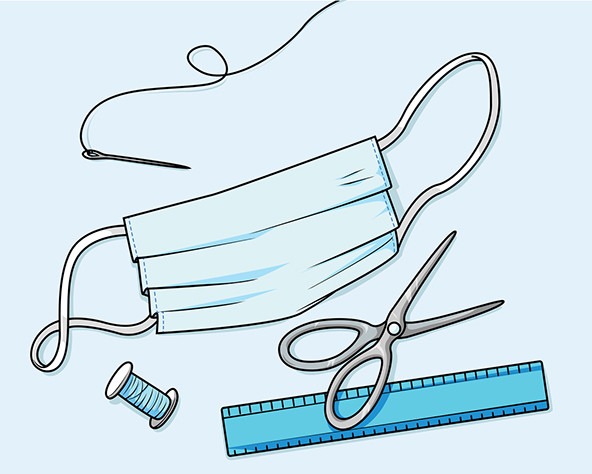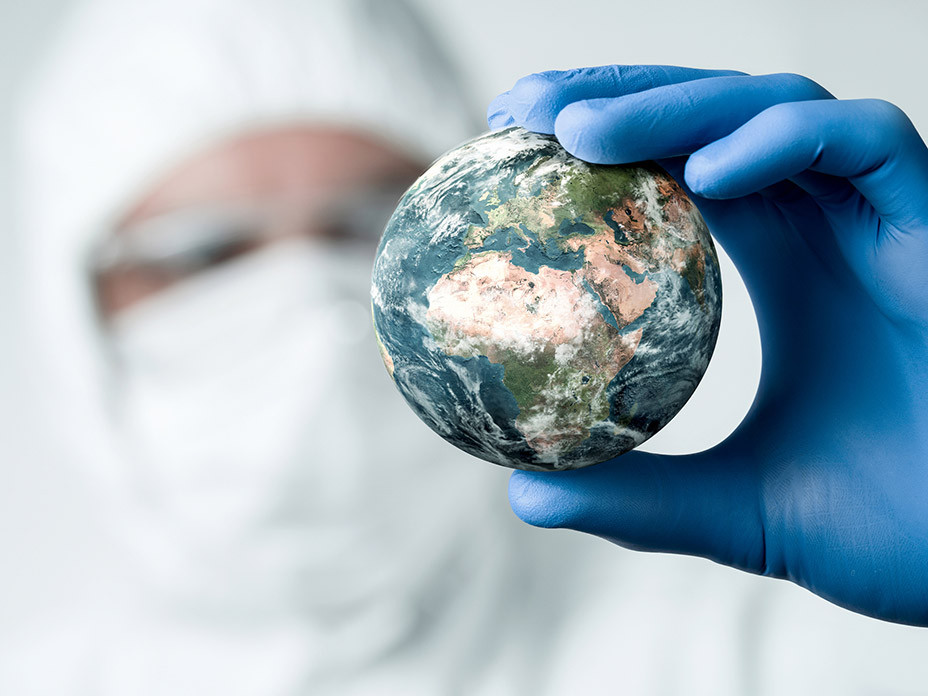 (Illustration by iStock/WestermannCreative)
(Illustration by iStock/WestermannCreative)
Faced with the COVID-19 pandemic, civil society organizations and governments around the world have been caught off guard. As they continue to struggle to respond, a concept known as frugal innovation may help them develop better and cheaper solutions at the rapid pace that is essential to controlling the spread of the disease.
Over the past decade, we have researched and written about frugal innovation—sometimes referred to as jugaad—in various sectors around the world, including health care. As the COVID-19 crisis continues to unfold, the co-creation of such innovations among health care practitioners and ordinary people is at an all-time high. For instance, Germany’s government hosted an open innovation hackathon involving more than 26,000 people to identify responses to the pandemic. The solutions typically fall into three broad areas: prevention (such as protective gear, hygiene, and social distancing), services and technology (such as devices, new procedures, and pop-up hospitals), and potential cures (vaccines and drug development).

Our analysis of many of these responses suggests that they apply four underlying principles of frugal innovation: reuse, repurpose, recombine, and, informing all of the others, rapidity. Organizations can use these principles to help address challenges arising during and after the pandemic.
1. Reuse
This entails finding available but outdated resources and using them in new ways without requiring much alteration.

Hydroxychloroquine and chloroquine—drugs from the 1950s that have grown largely ineffective in treating malaria—provide one example. Though the US Food and Drug Administration (FDA) recently revoked its COVID-19-driven authorization of emergency uses of the drugs, the government stockpiled millions of the pills to potentially use them to help combat the disease. Though there is no evidence that these drugs work against COVID-19, the initial decision, flawed though it may be, reflects the reuse principle—something outdated being considered again. More recently, dexamethasone, another globally available and affordable drug in use since the 1960s, has been clinically found to be effective in treating COVID-19.
Worldwide, governments are asking local residents and businesses to improvise and produce masks, gloves, gowns, and other personal protective equipment (PPE). In part, this reflects the weaknesses of a monolithic supply chain: China provided about half of all PPE equipment before the pandemic, and when the nation restricted exports, everyone else has had to find other sources. Creative solutions include using a hole puncher and overhead transparencies, resources designed for a pre-digital era, to make protective shields. As a short-term measure, Vice President Mike Pence of the United States asked the construction industry to donate their respirators to the health care sector. The chemical, construction, and other sectors could also reuse many of their assets to shift toward a more robust supply chain that includes a greater degree of local, decentralized manufacturing.
2. Repurpose
This involves altering a currently valuable resource to serve an originally unintended purpose.
Medical staff around the world, including in New York City, have had to repurpose garbage bags into clinical gowns and ski goggles into safety glasses. France's high-speed trains have been repurposed into ambulances to transport COVID-19 patients to less busy hospitals. Indian and Pakistan railways have turned their trains into intensive care wards, which can move to keep up with the spread of the virus. Warrington Hospital in Britain repurposed devices originally designed to treat sleep apnea to treat COVID-19 patients. The devices have led to much faster recovery rates, are less intrusive than ventilators, and cost a fraction of the ventilators graded for intensive care. In Italy, a 3D-printing company worked with hospitals to modify a readily available snorkeling mask to create a ventilation-assisted mask. The firm made the design available to anyone.
In Senegal, researchers repurposed a Dengue fever test kit to develop a $1 coronavirus version that gets results in just 10 minutes. They aim to produce the kits in large numbers for other African nations. In Denmark, a veterinary scientist undertook a repurposing project that could be scaled to many other livestock-producing countries. This researcher from the Faroe Islands repurposed his lab—long used to test salmon for viral infection—to test for coronavirus in humans. His work led to 10 percent of the population being tested, more than anywhere in the world. Countries showing low official incidence rates as a result of low testing rates could follow the example and consider repurposing existing veterinary clinics.
3. Recombine
This describes the mixing of resources, processes and practices among nonprofit organizations, governments, and for-profit businesses across different industries.
In terms of recombining limited resources, the Chinese built a 1,000-bed hospital from scratch in 10 days using pre-fabricated construction techniques used mainly in large-scale housing developments, an impressive feat. The English National Health Service (NHS) took a slightly different approach, but drew on the same principle of recombination. In a nine-day process of turning a large exposition center into a 4,000-bed temporary hospital, it combined its own skill in medical care provision with the military's skills in logistics to repurpose existing convention facilities. Also in Britain, the OxVent initiative by Oxford University and King’s College developed a ventilator by recombining off-the-shelf components already in the NHS’s supply chain. In New York, the capacity of individual ventilators has been multiplied several times with 3D-printed connectors that split the oxygen from a ventilator into several streams that can simultaneously treat multiple patients. In another example, more than a million volunteers recombined their personal computer processing power into a network—which was notably more powerful than the fastest traditional supercomputer—to sequence coronavirus protein structures.
In terms of processes and practices, Oxford University and Queensland University partnered with pharmaceutical companies to accelerate the readiness to distribute promising vaccines by setting up manufacturing capabilities as they ran clinical trials. There are ways to do more to speed up the distribution of vaccines. For example, companies can use their supply chains to distribute medicine. ColaLife, a social enterprise, did just this in 2011 when it used Coca-Cola’s distribution channels and assets to deliver antidiarrheal kits to remote villages in Zambia.
4. Rapidity
In the face of a fast-moving virus that becomes exponentially deadlier the longer it goes unchecked, interventions that move more quickly will be more useful. And given the complex nature of the problems posed by COVID-19—they touch upon health, social behaviors, economics, and many other areas of life—it makes it difficult for a single organization or even nation to instantly have all the resources it needs to effectively respond. Rather than slowly developing those solutions from scratch, speed must be of the essence. Reusing, repurposing, and recombining existing resources offer a faster route to fixes. But each of these frugal innovation techniques must also be executed speedily.
The good news: We have observed that frugal innovation efforts—such as for-profit businesses collaborating with nonprofits to provide social and economic value—typically deliver more impact, more quickly.
For instance, the British government provided a list of specifications for the manufacture of a ventilator system that exhibits many features of frugal innovation. The specifications call for the device to: be simple to use; require little training; be light enough to attach to patients’ beds; be small enough to avoid impeding hospital operations; be robust enough to keep working if dropped; and be made from materials readily available in British supply chains. An overarching concern with speed can be seen not just in the nature of these requirements, which focus on friction-free adoption and operation of the device, but in the name of the project: Rapidly Manufactured Ventilator System (RMVS). The appliance company Dyson spent about two weeks and $25 million to create a prototype. However, a collaborative effort premised on frugal innovation principles won out: While the British government initially expressed interest in Dyson's device, provisionally ordering 10,000 of them, it eventually determined it would take too long to get the newly designed devices from scratch into people's hands. Instead, the government fast-tracked regulatory approval of a design from the VentilatorChallengeUK, a consortium of more than 20 organizations from around the world, and placed orders for 15,000 devices. The consortium's approach to reuse existing production capacity, repurpose one of its member's existing anesthesia products, and recombine members’ individual sector-specific strengths led to rapid regulatory approval and the capability to scale up production for faster delivery.
A Frugal Future
Many epidemics in the past—Zika, Ebola, dengue, MERS, and others—have typically spread in less developed countries. COVID-19 has affected the whole world. In fact, as official numbers stand, wealthier countries seem to have the largest number of cases. As a result of this apparent failure or inability to respond to the crisis, more developed nations have turned to solutions that reflect frugal innovation principles. If there is something positive to be taken from this unexpected turn, it is that frugal innovation—with its highly collaborative nature and its ability to make the most of limited resources—can help to build a more inclusive, secure, and sustainable future. It may be just what is needed to face an increasing array of daunting problems, whether COVID-19 and the economic disasters it has triggered, a different disease, climate change, or other world-shaking threats.
Support SSIR’s coverage of cross-sector solutions to global challenges.
Help us further the reach of innovative ideas. Donate today.
Read more stories by Yasser Bhatti, Jaideep Prabhu & Matthew Harris.

